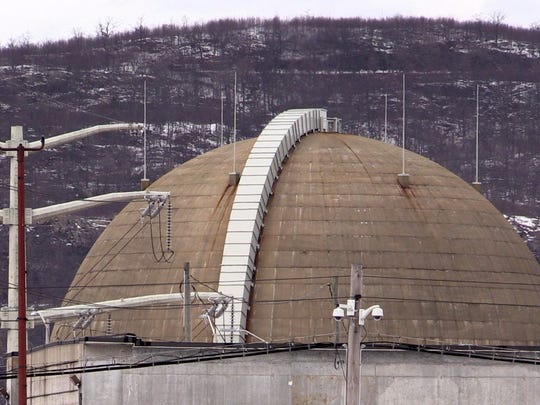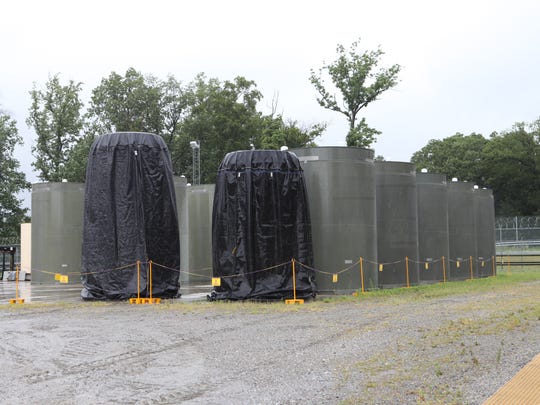This is not a good article. Not only is the 25 % still reliably parroted, but the reporting on CPV is almost as bad as the OLD reporting on IP used to be. And the article is surrounded by implications that Wind Power is not really a good thing, without saying so, and without elaborating on any of the (mostly photographic) implications. And the always inadequate focus on the price of energy as reflected in one’s bill, as opposed to the true cost of bad energy as reflected in our lives is always frustrating. So more work for us.
https://www.lohud.com/story/news/2019/01/14/waiting-watching-indian-point-sale-2019/2505924002/
This article contains some Entergy myths like the infamous 25% figure. It also has some interesting and useful lists of dates associated with the plant.
Officials in Buchanan and Cortlandt are keeping a close eye on developments as they ponder their future in a post-Indian Point world.
STORY HIGHLIGHTS
- Towns near Indian Point are facing the loss of millions of dollars in property tax revenues once Indian Point shuts down in 2021
- The head of the Hendrick Hudson Schools is leading the debate over his district’s future, eyeing possible cuts to programs
- Natural gas opponents are posing a challenge to a natural gas plant that opened in Wawayanda
To kick off 2019, lohud reporters are assessing the state of critical issues on their beats. In this story, reporter Thomas C. Zambito looks at the state of energy in the Lower Hudson Valley.
Indian Point will refuel one of its two working nuclear reactors in the spring, the last one for the Buchanan power plant on the shores of the Hudson River before it shuts down in 2021. The multi-million-dollar process of removing Unit 3’s fuel rods, replacing them with new ones and dropping the old into a pool of water until they’ve cooled enough to be entombed in cement and steel casks for eternity involves the work of hundreds of temporary workers who will descend on the Lower Hudson Valley for several weeks.
Work to replace the fuel rods at Indian Point 3 as well as the replacement, refurbishment and testing of equipment is underway as part of routine maintenance of the nuclear reactor in Buchanan on Mar. 20, 2017. (Photo: Ricky Flores/The Journal News)
Unit 3 started generating power in 1976. Its sister reactor, Unit 2, started two years earlier, and will be shut down in 2020.
The pending closure of the twin reactors not only means the Lower Hudson Valley will be free of a source of nuclear power for the first time in more than four decades.

It means other power sources will need to fill a sizable gap in the state’s energy grid. Indian Point’s owner, Louisiana-based Entergy, says the plant produces about 25 percent of the electricity used in Westchester County and New York City and at full power lights up 2 million homes.
On the beat
Gov. Andrew Cuomo envisions that energy gap being filled by harnessing renewable sources of energy from the wind and the sun, while making homes and businesses more energy efficient.
“As the federal government continues to ignore the real and imminent dangers of climate change, New York is aggressively pursuing clean energy alternatives to protect our environment and conserve resources,” Cuomo said last month.
Cuomo wants the state to rely on renewables for 50 percent of its energy needs by 2030. And in 2018, he took steps to jump-start that process, including creating financial incentives for companies to build wind farms off Long Island’s Atlantic coast.
Proposed wind farm off the coast of Long Island draws local fisherman’s attention John Meore, jmeore@lohud.com
But will it be enough? Or will natural gas plants opposed by environmentalists be called on to bridge the gap as they have in other states when nuclear power plants have shut down amid market pressure created by the cheap price of gas.
Those issues and more will be at the forefront of the state’s energy discussions in 2019.
What to watch for
Will Entergy sell Indian Point to a decommissioning firm like it did its Vermont Yankee Plant in 2018? In October, the Nuclear Regulatory Commission signed off on Entergy’s deal to sell Vermont Yankee to a New York dismantling firm, the first such deal of its kind in the nation.

If Entergy does the same with Indian Point, it could speed up the decommissioning of its two reactors and perhaps open up a portion of the plant’s 240 acres to new development sooner than expected. It’s likely Entergy won’t publicly reveal a decision until Indian Point is closed.
Entergy has been clear about its intent to exit its merchant nuclear power business.
“We have agreements in place to sell our Pilgrim and Palisades plants (which will shut down in 2019 and 2022, respectively), and the company expects to ultimately pursue a similar commercial arrangement for Indian Point after the units are shut down,” Entergy spokesman Jerry Nappi said.
Indian Point’s neighbors in Buchanan and the Town of Cortlandt are anxiously awaiting word on Indian Point’s future. The village and town stand to lose a significant amount in annual property tax revenue – $2.6 million for Buchanan and $800,000 for Cortlandt – they’ve relied on for decades.
And the Hendrick Hudson School District would lose about a third of its $75 million budget.

Officials are hoping Cuomo makes good on a promise made in April to add $24 million in his 2019 budget to aid communities hurt by power plant closings. The money won’t become available until the plant closes in 2021. “That money needs to be appropriated every year as a nest egg so that when we need it, it’s there,” said Joseph Hochreiter, the superintendent of the Hendrick Hudson schools.
In its analysis of a post-Indian Point world, the New York Independent System Operator concluded three natural gas plants under construction could help pick up the slack once the plant closes.
But a challenge led by environmental groups like Riverkeeper continue to dog one of those new plants – the CPV Valley Energy Center in Orange County. CPV started generating electricity in August but to continue operation it will need to obtain a federal air permit and go through another round of hearings before the state Department of Environmental Conservation. A court has allowed the plant to continue operations while it pursues the approvals. At capacity, CPV in Wawayanda generates enough electricity to power 600,000 homes.
“This facility will enhance the reliability of the Lower Hudson Valley electric system, reduce annual electricity costs to New York consumers by a forecasted $700 million while reducing carbon emissions by an estimated 500,000 tons a year,” CPV Chief Executive Officer Gary Lambert said in October.
The plant was at the center of a federal corruption trial involving former Cuomo aide Joseph Percoco.
Why you should care
Rising costs for energy mean higher electric bills. State ratepayers are already paying an extra $2 per month to bankroll a multi-million-dollar bailout of three upstate nuclear power plants for the next 10 years. And, by 2020, ratepayers could see a 76-cents-per-month increase on their monthly bills to help jump-start the state’s offshore wind output.
Key players

Joseph Hochreiter – Hochreiter will lead the debate about the future of his school district. “The taxes are going to have to go up and the district is going to have to tighten its belt and I think our residents will have some educated decisions to make about whether they want to pay more taxes for the level of programs and services we’ve been providing,” Hochreiter said. In the coming year, tough decisions will need to be made about consolidating schools at every level. “We have classes with less than 10 kids in them and we’ve got to put a price tag on that to determine if we’re going to continue to make the decision to afford to fund those programs,” Hochreiter said.
Sandra Galef – The Democratic assemblywoman will continue pushing Cuomo to lend a hand to towns like Buchanan and Cortlandt that face the loss of revenue from power plants. As of April, there was $56 million in the state’s Electric Generation Facility Cessation Mitigation Program. Galef said if the governor doesn’t include the money in his budget, she will push fellow legislators to make it happen. “We want to be sure it keeps building,” Galef said.
Andrew Cuomo – The governor helped negotiate the 2017 agreement that led to Indian Point’s decision to close, following years of protest by anti-nuclear groups. He’ll need to deliver on his goal of having the state rely more on renewables to make up the energy lost once Indian Point shuts down while making sure neighboring towns can weather life without the power plant’s tax payments.
Key dates
Jan. 24 – The Town of Cortlandt holds a task force meeting on the Indian Point closure.
March/April – The last refueling and maintenance for Indian Point’s Unit 3 reactor before its scheduled shutdown in 2021.
By the numbers
76: The amount, in cents, electric bills will increase every month come 2020 to subsidize the expansion of the state’s offshore wind industry.
$2: Amount the average state ratepayer kicks in every month to finance a multi-million-dollar bailout of three upstate nuclear power plants.
600,000: Number of homes that get power from the CPV Valley Energy Center in Wawayanda.
$60 million: Amount of revenue the Hendrick Hudson School District projects it would lose in the four years after Indian Point shuts down in 2021.
13 percent: Average that taxes would have to rise to cover revenue lost by the Hendrick Hudson School District over the four years after the shutdown.
Source: https://www.gannett-cdn.com/presto/2018/09/06/PWES/f84ce23b-dc86-4554-aa20-c2049542c011-jm090418_Wind_14.JPG?width=540&height=&fit=bounds&auto=webp
By Thomas C. Zambito





